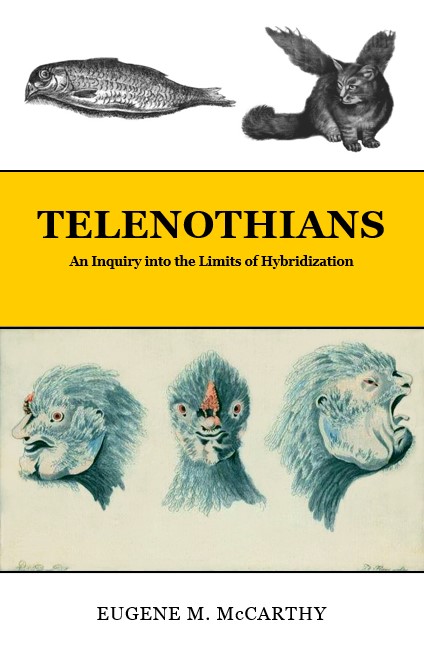Pig-human Hybrids
Recent
Mammalian Hybrids
This page was a draft for a chapter of my book Telenothians, available here.
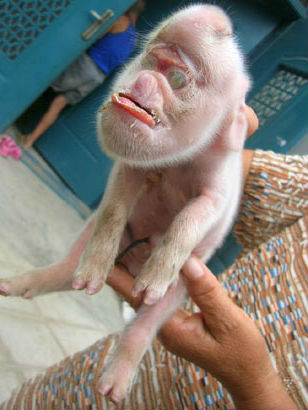 Strange “piglet” born in China in 2008. Note the presence of what appears to be an undetached frontal proboscis.
Strange “piglet” born in China in 2008. Note the presence of what appears to be an undetached frontal proboscis.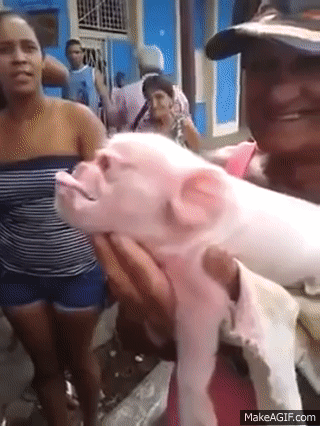 A case first reported from Ciego de Ávila, Cuba on Jan. 5, 2016, is shown in the video above. This probable pig-human hybrid died four days after birth. source
A case first reported from Ciego de Ávila, Cuba on Jan. 5, 2016, is shown in the video above. This probable pig-human hybrid died four days after birth. sourceBy those who choose to deny the possibility of distant hybridization, the condition shown here is often described as holoprosencephaly, a term used to refer to various malformations of the brain and face. In humans, the symptoms range from mild (e.g., anosomia or the presence of a single central incisor without other facial defect) to severe, for example, convergent eyes (or even cyclopia), absence of a nose, and/or the presence of a frontal proboscis (a tubular appendage attached to the forehead). Holoprosencephaly is a rare condition and its causes are not understood. The etiology is, in general, specified only vaguely as the result of a “disruption” in development. To the student of hybridization, the question of interest here is whether the disruption in such cases might be due to the incompatibility of genomes forced into interaction by the mating of two highly disparate types of organisms.
The reports differ with respect to the claimed degree of resemblance of the foreparts to those of humans. Some, however, do allege an exact similarity (see the transcripts of old newspaper reports). The most recent accounts of ostensible pig-human hybrids (for which photographic evidence is available) depict creatures with faces that are reminiscent of, but certainly not identical to, those of human beings. Indeed, several of these recent probable hybrids have a fleshy process like an elephant trunk attached to their foreheads, a structure known as a frontal proboscis. Frontal proboscides are also mentioned in some of the older reports.
A Chinese case (2015)
One of the most recent of these strange births took place on Monday, Feb. 9, 2015 in southern China. A sow belonging to Tao Lu, a resident of Yanan township in the city of Nanning, farrowed a “piglet” with a human-like face. Pictures accompanied the news stories. The animal was born alive, but died of starvation soon after birth. Nearly the last of a litter of 19, it was crowded out by siblings and unable to nurse. (Newborn piglets deprived of milk usually live only a few hours.) (A similar case occurred at about the same time in Scotland.)
The fact that only one individual from a litter of 19 resembled a human is not inconsistent with the possibility that it was a hybrid. When a litter-bearing mother, such as a sow, is multiply inseminated by different males, members of the same litter can have different fathers (“heteropaternal superfecundation”). Within the context of hybrid crosses, this means that a mother inseminated by two males, one of her own kind, and one not of her kind, can produce litters composed of both pure and hybrid offspring. (The former will usually make up most of the litter since the fertilization rate will generally be higher.)
Myanmar (2014)
Another, similar individual was born in Myanmar, in 2014, and is shown in the video immediately below. Though this video is one of the most convincing of any showing probable hybrids of this type, there is very little information available about this particular birth. Indeed, some sources say it occurred in Laos, not Myanmar.
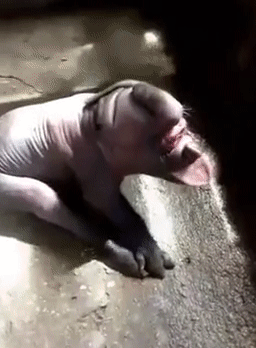 Another ostensible pig-human hybrid born in Ourolândia in the Brazilian state of Bahia in 2021. Note the presence of a frontal proboscis, a feature frequently seen in these composites.
Another ostensible pig-human hybrid born in Ourolândia in the Brazilian state of Bahia in 2021. Note the presence of a frontal proboscis, a feature frequently seen in these composites.
Video of an ostensible pig-human hybrid (filmed in 2012). The first view of this strange birth appears two minutes into the video.
Another Chinese case
The zona pellucida (ZP) is the outer layer of a mammalian ovum (female germ cell). The following is copied and pasted from the section entitled "Human Sperm Are Able to Bind to Pig ZP and Undergo the AR" in Canovas et al. (2007), who state that "The results shown in this work indicate that human spermatozoa can bind tightly to the ZP from in vitro matured pig oocytes. Besides, the induction of the human AR when human sperm were incubated with pig oocytes for 2.5 hours indicated that the binding was active and it led to AR." (AR stands for acrosome reaction. The acrosome reaction is the process by which a spermatozoon penetrates an ovum.) Pigs are not the only non-primates to whose ZPs human sperm will bind, however, in the present context, they seem to constitute the most germane example.
In the summer of 2008, news stories surfaced on the Internet picturing a creature said to have been born in a litter of piglets farrowed by a sow belonging to Feng Zhanglin, a resident of Xiping township in the province of Hunan in China. The animal (shown at the top of this page), described as a monkey-pig, was born July 19, 2008. The pictures associated with the various stories look real, but what is this creature? An actual pig-monkey hybrid? A strange, complex mutant? Many have suggested it’s a pig-human hybrid.
The various brief articles about this birth give anecdotal descriptions of the reactions of the family (e.g., Mrs. Feng was frightened of it; Mr. Feng abandoned it; their son recovered it and fed it, etc.) and tell how neighbors crowded the Fengs’ yard and how reporters rushed to the scene. But I have been unable to obtain any more recent reports relating to this very unusual birth, nor even a single serious scientific assessment of the animal. So at present it’s unclear whether this “piglet” survived to adulthood or whether, in particular, the nature of its origins have been evaluated via genetic testing. (If you have additional information, please contact the website.) Here are links to additional pictures of this creature:
A Central American specimen
In August 2011 a sow in a remote Guatemalan village (Santa Cruz El Chol, Baja Verapaz) produced another such “piglet” with a humanlike head. Its appearance, rather similar to the 2008 Chinese “monkey-pig” shown above, was recorded in television news reports, one of which is shown in the video above.
An additional case
Another such creature appears in the video at right. It has a frontal proboscis, which is similar to that seen in the photo above of the "man-pig" born in China in 2015, but the proboscis is free-standing. This is simply a video I found on YouTube and there is no information in English about where or when it was made. But a reader wrote in to say that the Hmong language is being spoken. The Hmong live in the mountainous regions of southeast Asia (if anyone understands what is being said, please let me know). It’s interesting in this connection that an old report about an alleged human-cow hybrid, quoted elsewhere on this website, pictures a creature with a frontal proboscis.
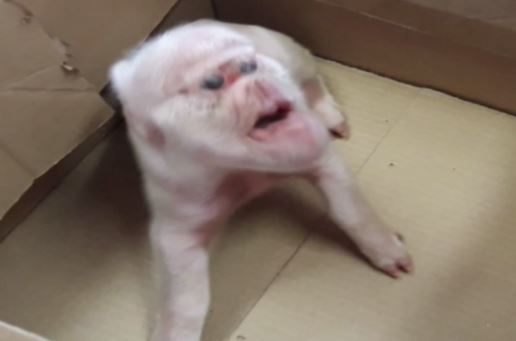
Above: A specimen farrowed in Hungary in August 2018.
By the same author: Handbook of Avian Hybrids of the World, Oxford University Press (2006).
 A probable pig-human hybrid born in southeast Asia in 2014.
A probable pig-human hybrid born in southeast Asia in 2014. 